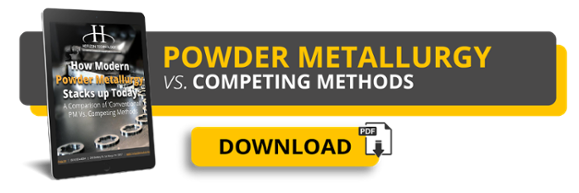Powder metallurgy is a manufacturing process that’s a leading candidate for both prototype and end-use parts across an increasing range of industries. More design engineers are turning this technology because of its ability to provide a low-cost or better-performing part. But there's another reason the powder metallurgy process has become popular -- out of necessity.
One of the most attractive aspects of powder metallurgy (PM) is how it's a green technology. This is a term thrown around by many companies, and it can mean a few different things.
Specific to powder metal, there are three key characteristics that make it more eco-friendly compared to conventional metal forming processes. Here’s how powder metallurgy green technology is defined in 2020:
3 Pillars of Powder Metallurgy Green Technology
Powder metal is poised to be part of a sustainable future for electric vehicle design. Here are three ways it’s already contributing:
- Low scrap rate through net shape forming; raw material is produced from scrap
- Unique, compact motor designs for material conservation and lighter weight
- Lower energy consumption via higher-efficiency powder metallurgy motor technology
1. Rock-Bottom Scrap Rate
Powder metallurgy is pro-sustainability right from the beginning. The metal powder your manufacturer starts with is mainly created via recycled scrap steel.
Compared to conventional manufacturing technologies like casting and forging, the powder metallurgy and sintering process uses about 15% less energy. It’s easy to explain these energy savings -- there’s simply far less need for secondary operations in powder metallurgy.
Some of the process steps that can be eliminated with PM include:
- Shearing
- Annealing
- Finish forging
- Hot deburring
- Descaling
- Grinding
- Boring
- Countersinking
- Broadening
- Milling
Everything above creates scrap. Eliminating or reducing these makes the factory a more sustainable operation while adding the bonus of saving you money and reducing lead time.
The efficiency of the process only trends upward from there.
The scrap rate of PM is only about 3% -- significantly less than conventional processes where metal is cut away rather than “added” or “built up.”
- Consider that conventional machining has a throwaway rate of up to 50%, depending on the part’s shape. Think about the size and shape of a compound gear with a flange, and the amount of metal you have to remove to reach your end shape. All those metal shavings end up in the trash, not back in your inventory.
- Stamping is pretty efficient, but it can only create 2D shapes -- you have very few options in the z dimension. New progressive die technologies have fixed this to an extent, but stamping still isn't a very flexible process.
- Casting is more efficient than stamping and machining, but not as much as you think. There are still sand, cooling, and machining waste considerations at play. In the end, total waste will depend on component size.
- Forging gets you a little closer to powder metallurgy’s efficiency, but the process itself isn’t as precise as PM. Flashing and trimming of excess steel is common, if not a guarantee. When you add in the high cost of heating operations, forging becomes even less attractive.
While it's true that you occasionally need a secondary operation in powder metallurgy to reach your end goal, it’ll have little effect on your scrap rate. Bottom line: PM only uses the amount of material that’s required to create the end part.
2. Lighter, More Compact Motor Design
The powder metallurgy process creates components that are sustainable in two notable ways.
Heightened emissions standards in Europe, Asia, California, and elsewhere have increased the need for more efficient vehicles through the use of “electrification.” By using advanced materials and processes, powder metal parts can create a new standard in electric motor efficiency.
- Soft magnetic composites allow you to create parts with better magnetic performance, reducing heat loss.
- Ultra-high-temperature sintering combined with advanced sintered magnetic alloys solves the debate of whether powder metal is the technology of choice for today’s high-speed DC applications.
And as more consumers demand eco-friendly vehicles and automakers invest their efforts in them, powder metallurgy parts have the potential to help meet and exceed their short- and long-term goals.
Powder metallurgy’s 3D shape-making ability improves efficiency in another way: It saves space and weight. Because you can create unique, complex geometries, you can use less material and take up less space in the vehicle’s design. If the part is sintered at high temperatures, it can maintain high strength despite being lightweight. Lighter vehicles are, of course, going to use less fuel -- a win-win both for manufacturer and consumer.
And while the cost of powder metallurgy may initially be greater than that of conventional methods, you'll save money in other ways. The net shaping capability allows for composite shapes that consolidate a design. You might just be able to turn a three-part assembly into a single part!
Beyond automotive motors, powder metal components can pay big dividends in other types of electric motors. Check out this case study of ceiling fans.
3. Easy on the Electric Bill
The final advantage of powder metallurgy is more on the consumer’s side -- low energy use.
Today’s consumer can buy an electric-intensive vehicle providing creating greater comfort and performance with additional advantages in total cost of ownership.
Other Advantages -- and Disadvantages -- of Powder Metallurgy
The powder metallurgy process is simple, yet highly involved. You melt the steel, then press and sinter. Your manufacturer can efficiently pump out high volumes of parts and assemblies with reduced weight, greater magnetic qualities, and compact design.
Material and process efficiency is only part of the debate between powder metallurgy and competing process. Learn more about the advantages and disadvantages of “conventional” powder metallurgy vs. forging, machining, casting, metal injection molding, 3D printing, stamping, and electrical steel laminations by downloading the free e-book below:



